Well, it’s apparent you all appreciate history as much as we do.
When we broke the news last month about re-discovering the Neptune Spring on the West Baden Springs Hotel property, the response on Facebook was overwhelming. 7,000+ likes, loves and “wow”s. 3,000+ shares. Nearly 900 comments.
We received a lot of questions about it, and today we hopefully have a few more answers as we continue working to revive this historical site. Chuck Franz (Vice President of Cook Group, French Lick Resort’s parent company) and Justin Harris (French Lick Resort’s Director of Facilities and a licensed engineer) have been working closely on the project, and here’s what they can tell us about this 130-year-old spring that has been freshly unearthed.
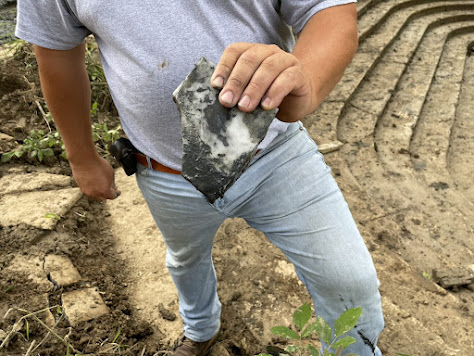
Some of the marble and glazed brick from the bottom of the spring house basin is still remarkably well intactafter100+ years of being exposed to the elements.
Q: Is the spring still flowing?
Justin Harris: “That’s something we were curious to see when we first uncovered it, and we found that the spring is still flowing. We can pump out all the water from the spring basin, and within 12 hours it will fill up to that third step from the top, about 5 feet deep. It’s still flowing at 2 gallons per minute — historically it was 4-6 gallons per minute. It’s the only active original spring to the West Baden property, since all the other springs had been capped.”
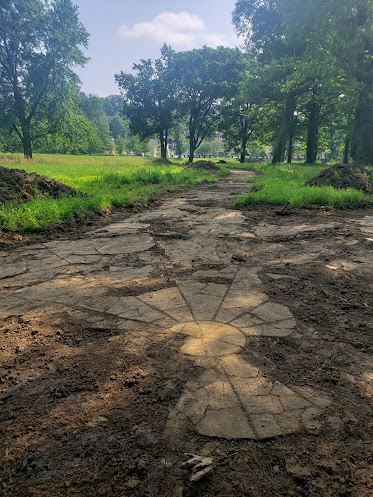
Q: What are the plans for this area — the wooded walking paths that have been dug out, and the spring itself?
Chuck Franz: “The pathways that we uncovered aren’t in the greatest condition yet, but we’re going to level all these pathways and revitalize them. This area used to be called East Park and we want to bring back this entire East Park area, because it does have a lot of history, and allow our guests to walk the grounds.”
Justin Harris: “The original paths that lead to the spring were made from concrete panels that were an inch to an inch-and-a-half thick, and after being buried for so many years, it broke up into a cobblestone-type surface. Those paths aren’t safe for public consumption yet, but we’re working to get them restored. As far as the spring basin, we’re figuring out a better way to protect the area rather than just some steel barricades. We plan to continue to work throughout the summer on this, and have it a feature just as quickly as we can. There’s a lot of curiosity, a lot of interest in this area.”
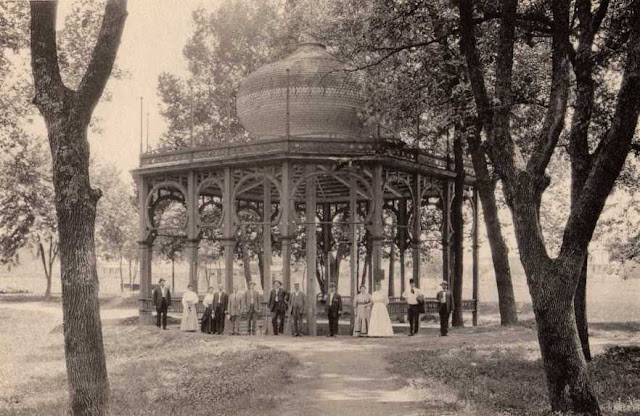
Q: Is it possible to rebuild the original spring house structure?
Justin Harris: “If we were able to rebuild something similar to the original structure, we would fall into the same issues that the original hotel owners had, which is the frequent flooding of this area as it sits in low-lying grounds. If you built it out of wood, of course you’re prone to the wood rotting. We’d have to modify that and make that bottom portion concrete or stone. It just doesn’t seem very feasible to do that. The people back in the 1800s were craftsmen, and they did a lot of work that’s very difficult for us to replicate without getting too much technology involved, and then you kind of lose the historical nature of what it was. And the cost of doing that would be significant.”
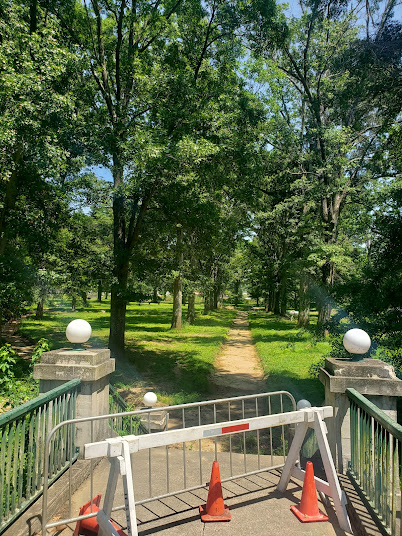
Q: Can I come see the site?
Chuck Franz: “We’re still working on it. Until we can reroute the spring and get that water so that it drains effectively, we really want to keep people away from it at this point in time while we continue to work on it.”
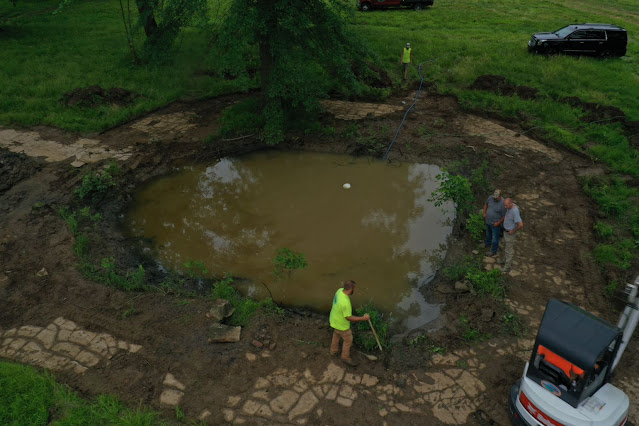
Before and after of the Neptune Spring cleanup
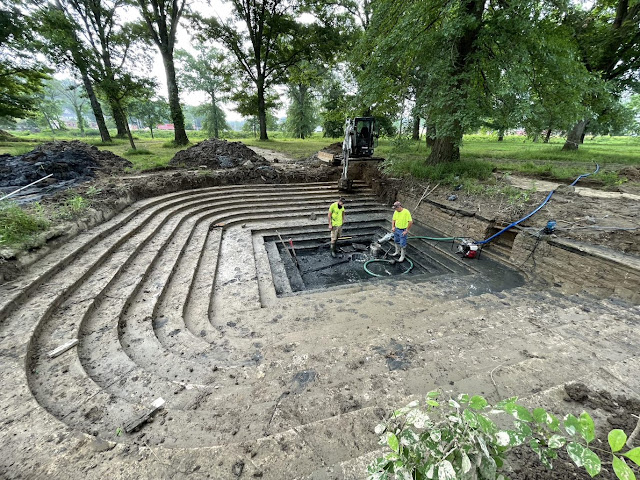
Q: What’s the next step for the Neptune Spring?
Justin Harris: “Between the natural spring water that fills up the basin and rainwater that collects there, the basin is going to have some water in it until we put some kind of a drain system in. We’re in that planning phase of trying to find a solution to that problem.
I don’t know how they did it back in the day, but the original Sprudel House (a short distance away in what are now the West Baden Springs Hotel gardens) was an area that our guests could come to and sample the waters from all the springs. That water had to get pumped somehow from the Neptune Spring into the Sprudel House for the sampling. I don’t know how it worked, and it doesn’t currently work; it doesn’t want to flow by gravity into the creek. We’re probably stuck with pumping it in some capacity, but we have to overcome the obstacle of getting power out to this area to install a pump, and then ensuring it’s elevated or protected enough when we get high water in this area.”
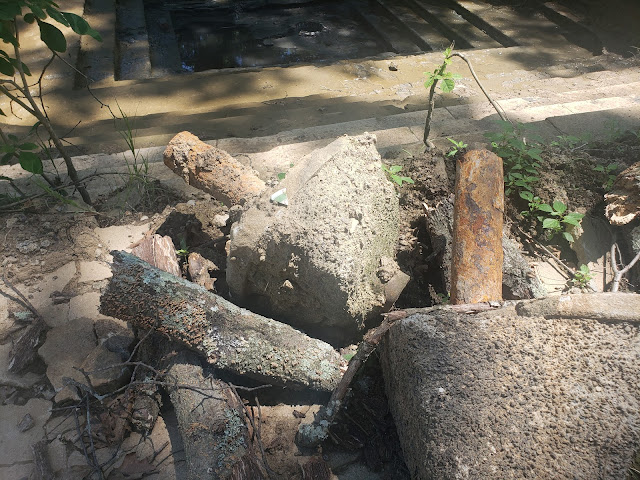
Digging around in this area produced a few other discoveries, like these stakes below sticking out of rock remnants. Originally, these stakes were anchored into the ground and supported the wooden spring house structure that surrounded the spring.
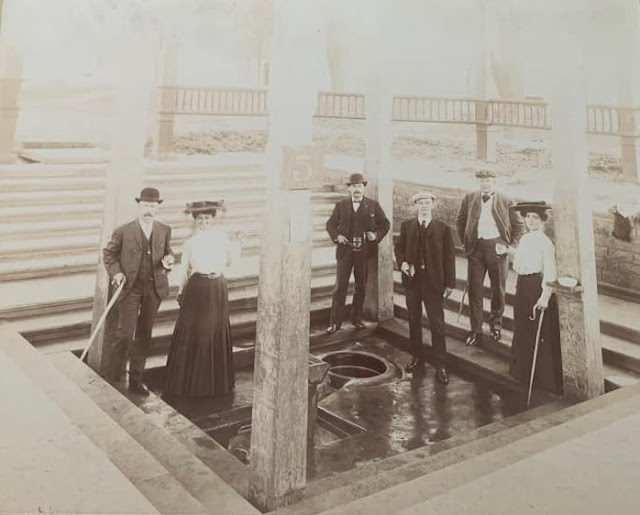
Q: Amazed by the history that’s been dug up here?
Justin Harris: “The spring basin is actually still intact, and it’s very well preserved. It’s a miracle, because it’s made of cut sandstone. It sat in water so long that the sandstone gets a little soft by nature, but you can still see where the basin is carved sandstone with radiused corners. To still have that sandstone base is really cool.
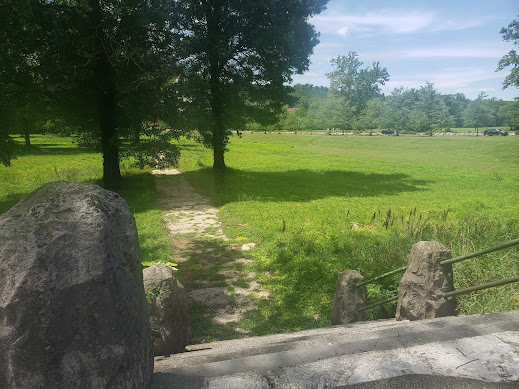
This is one of my favorite areas on the property of West Baden We’re flanked by these massive red and white oak trees that are over 100 years old, and then you have the staircase coming from the bridge. (A train station was once here, and guests could walk down the stairs and through East Park to reach the hotel.) You can tell this East Park area was a focal point of something. And now, it’s a nice area to walk – it’s peaceful, it’s quiet, it’s shaded, nice breeze. I can see a lady with a parasol and the gentleman in his suit taking a stroll this area in the late 1800s.”
The steps leading down into this area, where a train station
was once located. Down these steps and to the left is where
Neptune Spring is located. Through the trees is West Baden
Springs Hotel, and the hotel's brick driveway is in the
distance on the right.